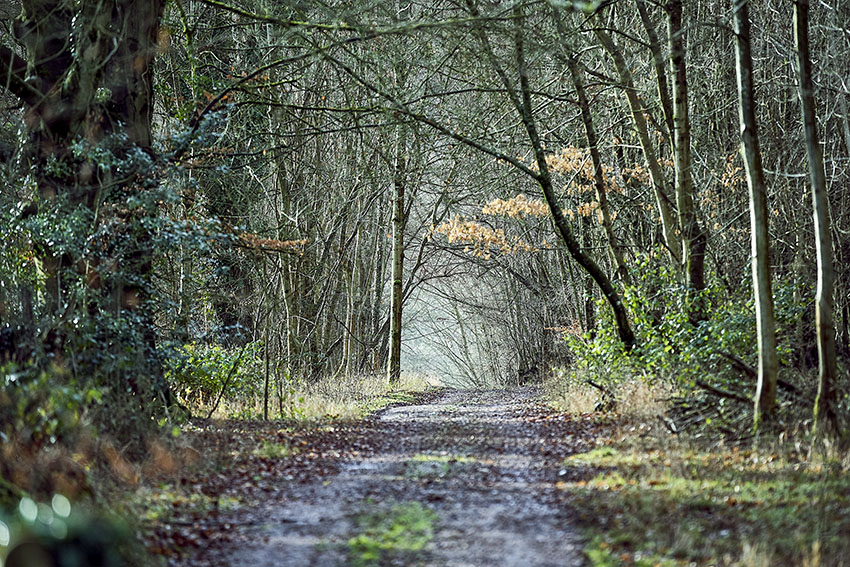
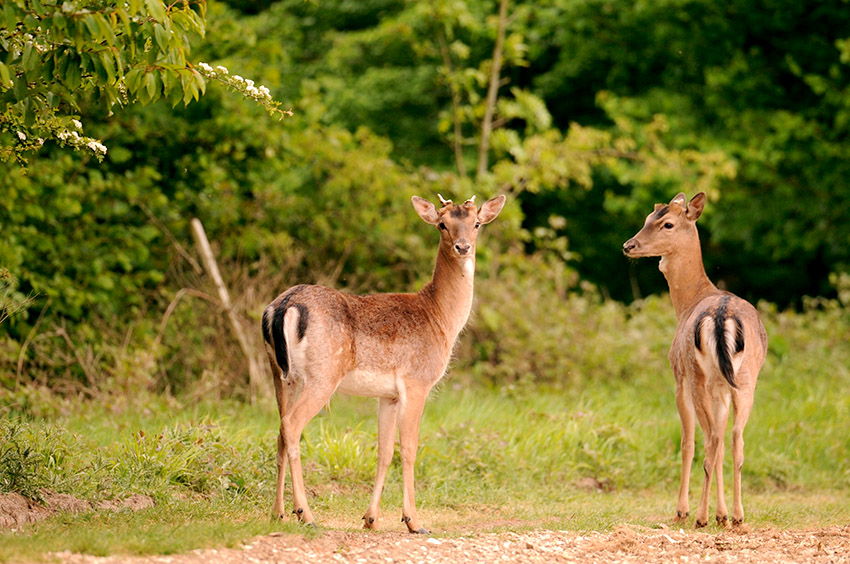 Walk through the woods and downland in this part of the world and you might catch sight of no fewer than three different types of deer: Roe, Fallow or Muntjac. They are always quite shy animals, standing silently still for a moment assessing you before bounding away on long elegant strides, disappearing into what seems to be impenetrable thickets.
Walk through the woods and downland in this part of the world and you might catch sight of no fewer than three different types of deer: Roe, Fallow or Muntjac. They are always quite shy animals, standing silently still for a moment assessing you before bounding away on long elegant strides, disappearing into what seems to be impenetrable thickets.
Roe deer are regarded as a native species and remain widespread across woodland, farmland, grassland and downlands. They are quite easy to distinguish as they have pale rumps which are clearly visible as they bound away. Fallow deer are considered to be naturalised rather than native as they were introduced following the Norman Conquest in 1066. Given that is over 1000 years ago now, it seems a little unfair to suggest that they don’t really “belong” but then I am not a naturalist.
Muntjac, small mid- brown deer about the same shape as a medium sized dog, are really quite new having been imported only in the last two hundred years but have flourished, spreading rapidly throughout England.
 They are inveterate browsers, eating the shoots from shrubs, as well as woodland herbs and brambles. They are therefore not necessarily good news in gardens nor in wilder areas, as it thought that clearing the woodland undergrowth is linked to a decline in bird species such as nightingales.
They are inveterate browsers, eating the shoots from shrubs, as well as woodland herbs and brambles. They are therefore not necessarily good news in gardens nor in wilder areas, as it thought that clearing the woodland undergrowth is linked to a decline in bird species such as nightingales.
The trick is to manage populations so other species are not driven out which always requires some subtle observation and detailed knowledge of habitats and wildlife to get it right.
At this time of year however, we are all more focused on reindeer rather than our native deer. Until 800 years ago you might have found wild herds of reindeer roaming in Scotland. They were probably bought to extinction by over hunting – the Vikings certainly hunted them, but sixty years ago they have now been were reintroduced in the Cairngorms in Scotland. They are social animals and they feed, travel and rest in herds. They eat reindeer moss, grasses, sedges, the leaves of willow and birch trees and are built for the cold: their noses warm up air before it gets to their lungs and their entire bodies are covered with fur.
Sadly, real reindeer cannot fly but they can certainly run, reaching a maximum speed of 50 mph. Most of them live in Lapland where there are more reindeer than people – about 200,000 reindeer versus 185,000 people. Without doubt, along with Father Christmas himself, they are the most potent symbol of Lapland and are famous around the world for powering Santa Claus’s sleigh.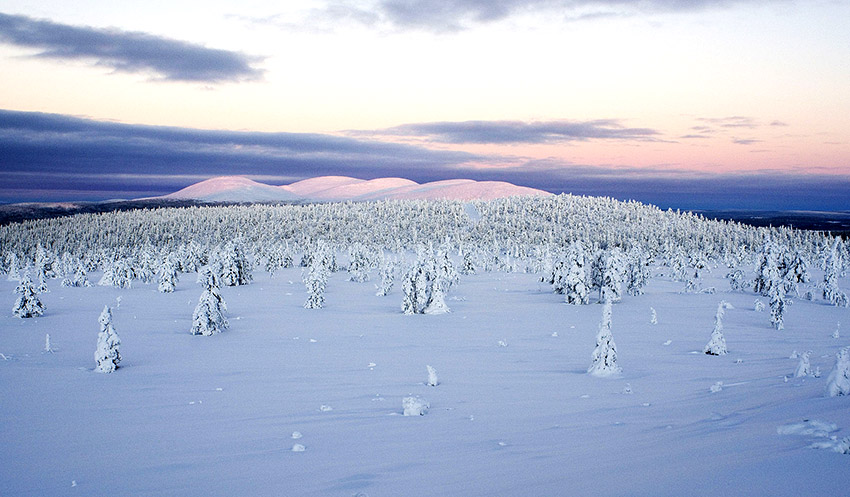
In reality, both the indigenous people (the Sami) of Lapland and the reindeer are scattered across the northern regions of four different countries: Norway, Sweden, Finland, and Russia. The Sami have a unique language and way of life rooted in the traditional husbandry of reindeer and both are under threat. The traditional roaming routes are challenged because of the fragmentation of the Arctic both in terms of climate change and the artificial country borders which cut across migration routes and herding pastures, whilst industrialisation is impacting their traditional life. The Sami argue they live in Sápmi whilst accepting they earn income tending reindeer as well as other revenue streams such fishing, agriculture, and tourism.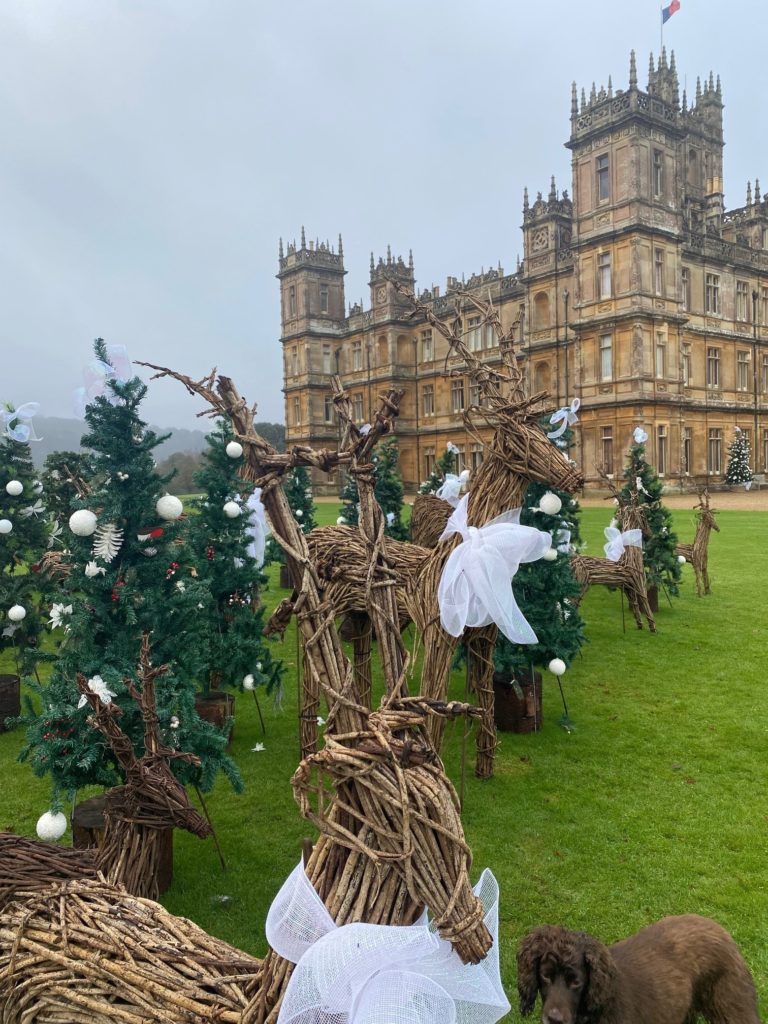
Sally, our chief Christmas elf, took the more sustainable route of a herd of reindeer made from willow which stand on the East Lawns of the Castle. They are rather firmly tethered as we have had some high winds at Highclere and Santa’s reindeer are not quite due for take-off just yet.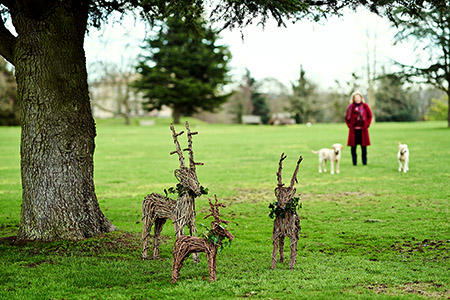
However, some of their decorations do periodically become detached and fly away but kind visitors return with them from the gardens in a type of real-life scavenger hunt. Our sledge meanwhile is firmly ensconced in Luis’s banqueting marquee where it can’t make a premature dash for freedom, loaded with presents and ready for the big day.








 Instagram
Instagram
Wonderfully educational! Thank you! Merriest of Christmases to you, your family and staff!!
Merry Christmas!
Merry Christmas and Happy New Year from Finland, the land of Santa and reindeer!
Merry Christmas
A very Merry Christmas from warm, sunny Orlando, Florida. Always, thank you for your wonderful blogs.
Thank you.
Merry Christmas.
Rachel from Indiana, USA.
Dear Lady Carnarvon,
I especially enjoyed this weeks writings of the deer….these are some of my favorite animals, having had quite a few of them over the years. Whitetail, and a Sika deer, but my true love was my reindeer Lulu. She and I would hike for hours and she had the sweetest personality. You reminded me of my time with her.
All the creatures great and small, I must say, I love them all…a merry Christmas to you and your family
Jenny
That sounds so amazing!
Very informative. At my ranch we get a couple types of deer like creatures, Mule Deer, Pronghorn Antelope and Elk. At my house we see the White Tail Deer from time to time. It is amazing to see these animals leap fences. At our last house the neighbor used to feed the deer in our backyard and so we got to see many newborns nestled in the foliage. Deer are so quiet unless you pay attention you might miss them altogether. Thank you for the seasons reflections.
Thank you!
Love your blog. Happy Christmas.
Thank you for this charming description of deer at Highclere. My family and I visited there in 2013 after falling in love with the series, Downton Abbey.
I will most certainly visit again.
Andrea, Chicago
Thank you
MY DARLING LADY FIONA ,
GOOD MORNING, WARM DAY 28° DEGREES CELSIUS,
BEAUTIFUL BLOG, LOVELY PHOTOS. WOW, GOLD WORDS .
MERRY CHRISTMAS FROM BRAZIL FOR ALL THE MONDAY FAMILY.
BEST WISHES MILADY FOR YOU.
I AM DREAMING ABOUT THIS NEW YEAR 2022.
VILLA ALEMÃ
RIO CLARO – SP
BRAZIL
That is very kind of you!
Happy Christmas. Stay warm and healthy. Wishing all at Highclere a wonderful New Year!
Happy New Year!
Dear Lady Carnarvon,
A wonderful behind-the-scenes look at Reindeer, both real & Willow ones!
I’ve visited the Reindeer Centre in the Cairngorms, such beautiful gentle creatures, especially the baby one who insisted on lying in the sleigh!
I wish you & everyone at Highclere *& all the dogs!* a VERY Happy Christmas & a safe & successful New Year,
Yours
Caroline x
Thanks for the reindeer history and update on these magnificent animals.
Reindeer are beautiful creatures
A good read. I sometimes have deer in my front yard. They are beautiful.
I really love and look forward to your emails! Thank you!
Have a beautiful and Merry Christmas!
Dear Lady Carnarvon,
Thank you for your lovely blog. I visited Highclere last week and honestly, it was like a dream come true for me. Thank you so much for sharing your wonderful home. It was everything I thought it would be and so much more. Thank you again and I hope that you have a wonderful Christmas.
Best wishes,
Emma
Thank you so much Emma
So beautifully written and so educational. I’m Michelle’s Auntie Trish. I met you a couple years ago when you had the concert in your garden. You were so gracious. It was a special day. I live in Los Angeles and I’ll visit Highclere again when travel is easier.
Merry Christmas.
Hope to see you soon
Highclere is a magical place. I was born nearby and moved to America in 1994 at the age of 14. Back in 2019 on April 17th I flew from Austin, Texas where I live to London. It was my 40th birthday. I visited Highclere that day and the weather was so beautiful and I had tea and spent nearly the entire day taking everything in. I still remember the most beautiful trees. I sat under a huge tree overlooking the house and it was just amazing and a memory I shall cherish forever.
Very kind of you
Dear lady Carnarvon l lovely the pictures of the reindeer and did you and lord Carnarvon have a nice weekend and happy Christmas to you and lord Carnarvon thank you for email and l lovely Christmas it my birthday on Boxing Day
Thank you Lady Carnavoron.
As an educator, I am always thrilled to learn something new. I will eagerly share this with my elementary students as we discover holiday themed traditions and fun facts from around the world.
Merry Christmas and happiest 2022 to you and your family, as well as all those who are on your team.
Thank you again.
Sherry Richards
Chicago, Illinois
HAPPY CHRISTMAS
Dear Lady Carnarvon,
I enjoy your blog posts enormously. Living in the Netherlands, with almost no room for this kind of landscapes and scenery, it’s wonderful to read about Highclere and it’s surroundings. Thank you for that, and best wishes from the Netherlands!
My husband is planning to fence and gate our acreage to keep out the deer. I’m quite sad about that.
Merry Christmas!
We are garden areas that are fenced too…
Happy Christmas !
My Father remembered when the deer from the Brabourne estate, near Ashford, Kent, provided meat for the people in the area during the privations of WW1. Food shortages were severe before rationing and people around Ashford remembered the generosity of the Knatchbull family.
Deer are lovely and very pretty but they also provide important protein. It is a pity that we rely on intensive farming rather than using the exceptionally good food sources in Britain that contribute to the ecology rather than destroying it.
Venison is in my cook books.
Happy New Year! What a lovely story about the various deer. It was such a pleasant relief from all the news we’ve just experience with the serious tornadoes. My grandfather’s hometown has been destroyed;; it was on my list of places to visit. Life can certainly take a sharp turn in an instant. That’s why I enjoy your blogs so very much. Highclere stands and the routine continues. While the Pandemic has disrupted much of life, Highclere persists.
Have a healthy and safe New Year!
Happy New Year
Merry Christmas to all the Carnarvon family and a happy and peaceful New Year! Thank you so much for all the blogs this year. As always a great read and always something to learn! Looking forward to visiting once again (Covid allowing!) in 2022!
Lovely again Lady Carnarvon,
Living in the woods of CT for 30 years I dealt with many many white tail deer over those years loving some but not happy with them when they ate all my tulip blooms in the spring and many bush sprouts and garden herbs. Did have to put up deer fencing in our back yard to protect my 7 gardens but left the front yard open so they could roam through.
Thank you for the educational information on the variety of deer as it was enjoyable to read and lovely to see the photos.
Seeing your life size stick woven deer made me smile as well as I have two mini ones that I placed on indoors on our fireplace hearth for years. Love seeing things in common with you!
Happy Christmas Season again to you and Lord Carnarvon and your families.
Happy Christmas Lynn
Dear Lady Carnarvon,
lovely blog this week. I never knew there were different breeds of deer. They are lovely animals, we used to get them on the Somerset Levels, we are lucky if we see any these days. Do you have deer on the estate? We have a lot of swans, ducks and herons, all wild, and of course Quantock ponies on the hills.
Kind regards,
Jane
Yes, we have a couple of different types on the Highclere Estate
Dear Lady Carnarvon,
I always look forward to reading your posts on Mondays! Thank you for another one.
My name is Lilah, and I am a University student in America. I have a private question about working at Highclere. Is there an email address that I could reach you at?
I hope to hear from you soon.
Kind regards,
Lilah
The best one is [email protected]
Dear Lady Carnarvon,
Thank you for the lovely pic`s & the beautiful all the beautiful deer, I just love them so much.
Merry Christmas & A blessed New Year To You & Your Family xx
All the best wishes,
Barbara from,
Long Island, New York
“…out through the fields and the woods, and over the walls I have wended; I have climbed the hills of view and looked at the world, and descended…” it is as if hearing Robert Frost and entering a John Constable painting! Your photo of the forest and the path, just swept us into the peaceful world of Highclere this gray stormy Monday, thank you for this fine story. And I love the deer, so gentle and so graceful really. Your willow reindeer are fabulous, too. A most Happy Holiday time for you and the staff at Highclere!
Thank you so much Catherine
Dear Lady Carnarvon,
If you could only find the reindeer with the red nose!
Happy Christmas!
Keep looking!!!
Merry Christmas and God Bless !!!
Lady Carnarvon,
I enjoyed seeing the different types of deer that live a lovely life at and near Highclere Castle. You have given me some fun questions for our monthly Quiz Bowl here at our retirement community! Thank you. Wishing you a Happy Christmas and a Healthy New Year!
Martha
I am very glad!!
Hi Fiona,
Fun fact, Santa’s reindeer are females. The males loose their antlers in winter while the females loose theirs in Spring after they have their calves.
So again the females are doing all the heavy lifting over Christmas
Merry Christmas
Best wishes
Jude
Beautiful photography of lovely scenery. The article is so full of knowledge. A very Happy Christmas to you and your family. Best Wishes forv2022!
Happy Christmas to you
Thank you for your wonderful stories and history lessons. It’s a joy to read. I want to wish you, your family and staff a Merry Christmas and happy, prosperous New Year. Much love to you and yours from this side of the pond…deep in the heart of Texas!
How very kind thank you!
Merry Christmas to you and your family, Lady Carnarvon! I enjoyed reading about the reindeer. My house sits just about twenty feet from a lake in southern California. At this time of year flocks of Canada geese fly in to spend the winter here. Every day several of them fly up and land on my roof, strolling back and forth, and sometimes having heated disagreements. I enjoy jokingly telling people that listening to their footsteps running across the roof, I now know exactly what Santa and his reindeer sound like!!!
Your photos are lovely. The first one makes me want to walk down that woodsy lane!
What a lovely idea!
YES, ” THE FIRST ONE MAKES ME WANT DOWN THAT WOODSY LANE.” WITHOUT PERSON , ALONE ,AT THE NIGHT OF CHRISTMAS.
Dear Lady Carnarvon
I hope all is well.
Thank you for the information about the deer including the willow variety. Wishing you and your readers the merriest of Christmases.
Kindly
Susan Marie
Thank you so much
*************************
Merry Christmas. ☃️
*************************
Merry Christmas
I love your blogs and this one particularly as deer are a favourite animal of mine. Educational and so interesting. Only one wrong fact – reindeer do fly!!!! My grandson told me and he is always right which you are when you are 5 years old.
Dear Lady C
It is heartwarming to read others’ comments and feel how much we share our love of your stories, Highclere , and yourself. It lifts my spirits to visit you, the Earl, your talented staff, and beautiful estate thru the blog, and enrichment is achieved via the knowledge you share. My only visit to Highclere so far was a dream realized and I am delighted to continue the connection through your blog.
Happy Christmas; healthy & prosperous 2022 to you and yours.
With gratitude and love
Cate Sullivan
Maine, USA
Merry Christmas and a Happy New Year
Lady Carnarvon, Such a wonderful story. I have always loved seeing deer. They are such a beautiful animal. I would give my eye teeth to see a reindeer. They are such an amazing looking animal. Stay healthy and safe. Chery Thompson.
Our house sits on the edge of a small pasture bordered by woods. One Christmas Eve as we returned from church, our headlights reflected on little orbs, which turned out to be a herd of about 10 white tail does. Our daughters paniced, thinking Santa was already at the house and we would disturb him! That’s a treasured Christmas memory.
That is so cute
Lovely thoughts as always. However, I live in the Central US (Iowa) where the weather is calling for a rare straight line wind storm today, with gusts possibly as high as 80 miles per hour, so I fear we may have more than our share of flying reindeer here by the end of day as well.
Thank you for your lovely post on reindeer. They are such beautiful animals and such a rare sight.
Mele Kalikimaka!
Dear Lady Carnarvon:
Thank you for your Monday blog. It is a welcome break from all the sad news we have been receiving about the tornado ravished areas.
Even though the e-mail arrived in a timely manner, I was unable to read the same until today.
Appreciated learning about deer in England and Scotland. Deer in Southeastern Michigan are not timid. They will walk right up to you, as if to say, “feed me” or “take care of me”. Some herds have become unmanageable, so sharp shooters are brought in the reduce the numbers.
I also saw the photographs and read the accompanying comment about the reindeer in and around Highclere Castle on Facebook and Instagram. Very nice.
Until next time, may you stay healthy and safe.
Perpetua Crawford